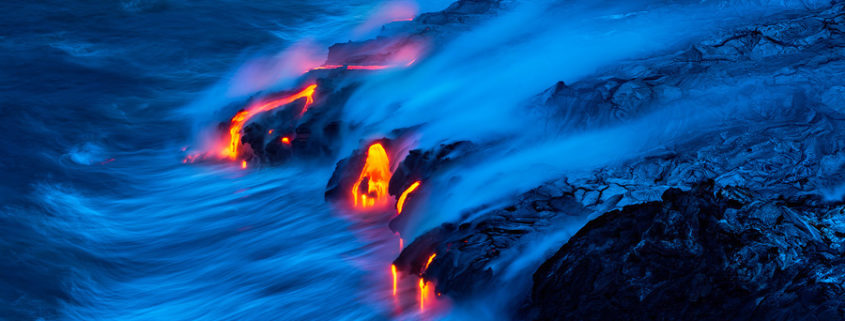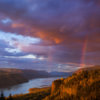Tips for Photographing Lava – Part I
Since lava from Kilauea is currently flowing into the ocean, I thought it would be a good time to provide some tips on photographing it. If you won’t ever be able to get out and shoot lava, some of these tips can be applied to photographing any rapidly-changing scene.
GETTING THERE ON LAND
On the Big Island, you currently have to hike about 4 miles on a gravel road to get close to the lava from the land. Or, you can rent a bike and get there faster. The road is bumpy, so I only recommend this for people with some experience mountain biking. You’ll also be riding in or out in the dark if you want to photograph the lava at night. This will make the ride that much more difficult. Be sure to bring at least one bright headlamp with you. They do rent bikes at the parking areas for the hike. However, they may not be open early in the morning or late at night, so getting a weekly rental from Hilo or Kona might be a better option.
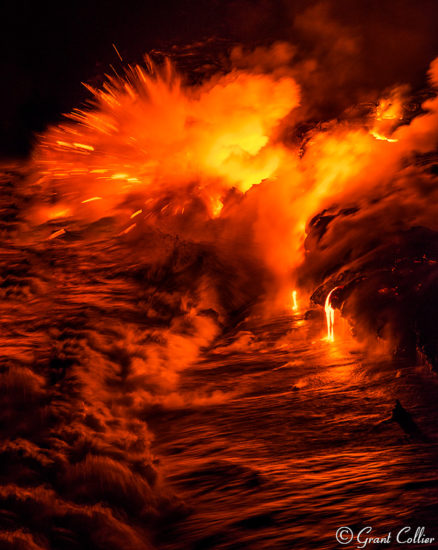
Lava entering the ocean can produce otherworldly scenes.
COMPOSITION
The viewing areas for the lava have ropes that you shouldn’t go past, so you won’t have a ton of different options for your composition. However, you should still spend time trying different compositions, both horizontal and vertical.
LENSES
I captured most of my images with a focal length of 95-125mm. However, the lens you need will likely depend on how much lava and smoke are visible on any given day. If possible, you should bring a wide range of lenses, from wide angle to telephoto.
SHUTTER SPEED
I recommend trying different exposure lengths. Longer exposures can blur the waves and smoke, sometimes producing a more dramatic effect. You may want to bring a neutral-density filter to get longer exposures. However, as long as you’re shooting during the optimal times – sunset, sunrise, twilight, and night – the light should be low enough to allow for longer exposures without a filter.
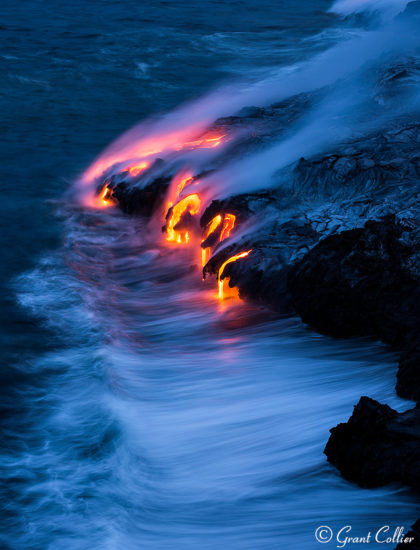
I used a long exposure of 1.6 seconds to blur the waves and smoke.
EXPOSURE
You’ll want to be careful not to overexpose the lava. You’re better off underexposing some areas than overexposing the bright highlights from the lava. Always watch your histogram. As long as you’re shooting in RAW, you can slightly overexpose the highlights and recover them in post-processing. But if you overexpose the image too much, you won’t be able to recover the details. Also, the scene will usually be changing too rapidly to take HDR images, so you’ll need to get the best exposure you can with a single shot.
TAKE REPEATED SHOTS
Once you find a composition and exposure time you like, I recommend setting your camera to take repeated exposures of the same scene using a remote release or your camera’s built-in timer. The lava, waves, and smoke all change very rapidly. Since it’s almost impossible to know the precise moment when the scene will look best, your best chance at a great shot is to take as many images as possible and later pick out the best one.
One bonus to taking many repeated exposures is that you can also create time-lapse videos of the lava. You’ll need to take 240 exposures to get an 8-second time-lapse video.
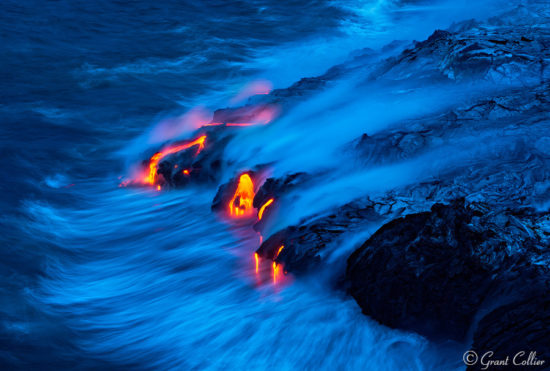
By taking repeated exposures every 2 seconds, I was able to capture this brief moment when the waves and smoke aligned to make a more cohesive and dramatic image.
SHOOTING AT NIGHT
If you shoot lava in the dark of night, it can be more difficult to get the exposure right. You will have a fairly extreme dynamic range, with some very dark areas and some very bright lava. Rather than setting your timer to take repeated exposures, you can take a few shots every time a wave breaks near the lava. The waves will reflect some of the glow from the lava, giving more light to the darker areas of the scene. The breaking waves will also add more drama to the shot.

The breaking wave reflected some extra light and added balance to this image.
STAY AS LONG AS YOU CAN
The lava is constantly changing in appearance, so the longer you stay the better chance you have of getting the shots you were hoping for. If you are lucky, a lava bench will break off into the ocean and produce a dramatic explosion. You’ll have to be prepared if this happens, as the explosion will usually only last a few seconds. So be patient and vigilant, and you should come away with some incredible images. I was only there one night, but by staying a long time I was able to capture all of the images seen in this article.
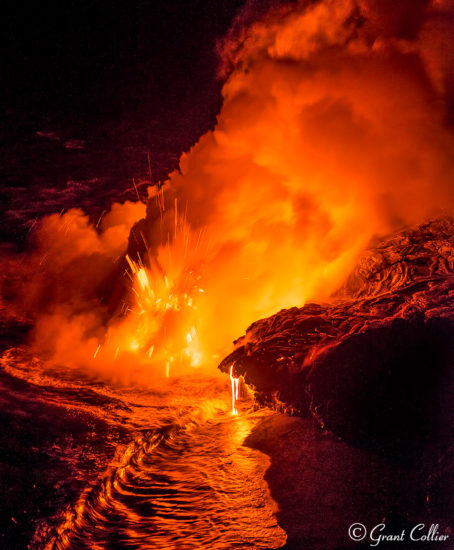
When a lava bench collapsed into the ocean, it produced this impressive explosion.
You can find additional information on the lava flow and current conditions at the national park website.
Coming up in next article: Photographing lava from a boat and from a helicopter.

